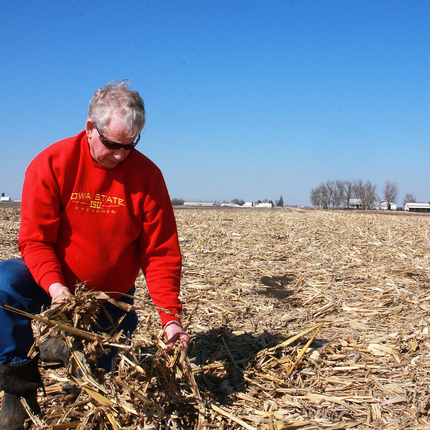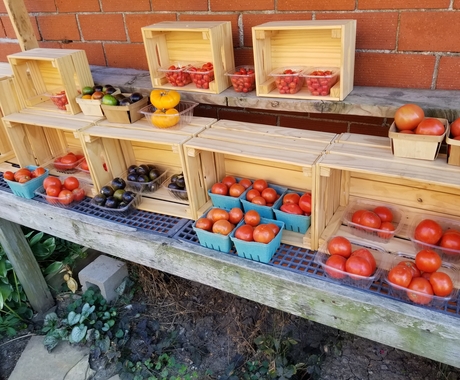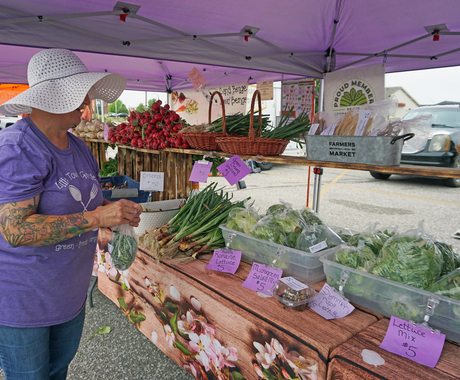This article appeared in Farm News on Oct. 26, 2020. Kate Hansen, former staff member, contributed to this article.
Dwight Dial knows that sustainability has many meanings, depending on whom you ask. To him, being sustainable means being able to answer a simple, but critical question: “Will I be able to farm next year?”
This question has guided Dwight through many chapters of new practices, conservation, and innovation during his farming career. Today, he plants cover crops, does no-till, and has established grassed waterways and wetland on his land, among other things. But the path to where he is now was forged one practical decision at a time.
After growing up on the family farm in Lake City, Iowa, Dwight ended up at Iowa State University studying agriculture education. In the early 1970s, he took his degree and taught for a few years in a small school in eastern Iowa. While he was there, he saw no-till being implemented in the area’s rolling ground. At the time, no-till was an emerging practice, and Dwight had never seen anything like it. He was intrigued, and the memory stayed with him.
In the spring of 1978, Dwight returned home, and began farming on his own.
He picked a good time to start.
“In those early years, the ag economy was really booming,” he said.
But by 1980, it was crashing and, after accumulating debt, Dwight needed to find a way to control costs.
“My dad and I started to look at what we were doing and I told him it wasn’t [economically] sustainable,” he said. “I crunched some figures and tried to figure out what we were going to do.”
Dwight’s memories of seeing no-till in eastern Iowa were still in the back of his mind. So when they had a particularly wet spring, he decided to give the practice a try in the best way he could.
“There were corn stalks and I couldn’t get into it and disc it up,” he said. “So, I suggested we call the co-op have them hook up a fertilizer buggy and scatter beans on top of the ground and I would go over and disc them in [later].”
His father was unsettled by the idea, to which Dwight replied, “what other choice do we have right now?” Ultimately, the soybeans came in, canopied early, and they had a good crop.
As Dwight and his father continued with the practice, and eventually bought a new drill, they became known locally as “trash farmers” because they stopped tilling in the crop residue from the previous year. But Dwight didn’t let the comments bother him.
Years later, as he manages the farm on his own, Dwight believes if making a field “pretty” doesn’t let him be sustainable, he’s not going to do it.
“There are a lot of farmers now [whose] fathers before them cared about aesthetics, but this next generation understands where we’re going with this to be sustainable,” he said. “With the way the ag economy is going today, you have to do that.”
Today, Dwight’s fields still turn heads, this time for his use of cover crops. After establishing a cover crop of rye in the fall, Dwight will plant directly into the field of living rye in the spring, and then spray herbicides to kill it off. The rye will die down, form a mulch, and then hold down weed pressure. The farmer is currently getting cost share to help with the costs of planting cover crops. But even after that finishes, he will continue the practice because it has proven to be economical.
“I’ve cut out one herbicide in corn and beans because of it, which is really about equal to what you’d be spending on the cover crop,” he said.
Dwight has also participated in Natural Resources Conservation Service (NRCS) programs, such as the Conservation Stewardship Program (CSP), which provides technical and financial assistance to help producers enhance conservation on their operations over five-year contracts.
With CSP, he has conducted soil testing, fertility testing, crop tissue testing, and created wildlife habitat. The soil testing indicated that his soil organic matter is quite high, more than 7 percent, confirming what Dwight has long known—his practices have an impact on soil health.
Working closely with NRCS staff, Dwight has also implemented grassed waterways, and turned a portion of ground into a wetland, among other projects.
Another recent undertaking has been installing solar panels on his hog barns. Using federal grant funds, tax incentives, and smart shopping, Dwight has found a way to make solar work for his operation. Before installing the panels, his summer electricity bills frequently exceeded $700 per month. Now, he’s paying about $15 per month.
These days, Dwight is glad to share what he’s learned with others. Whether inviting farmers to take a look at his practices, or splitting up planting duties with a neighbor to help him to try no-till, Dwight encourages those around him to try new things in their operations.
For producers thinking about starting a new conservation practice, Dwight advises, “take one farm, and just do one farm that way. Take the records, and figure out the bottom line on that enterprise and see if it was sustainable versus what you’re doing other places.”
For Dwight, conservation measures have led to notable soil health, erosion, and wildlife benefits on his land. He’s also seen economically practical benefits in his checkbook.
As he looks back at many years of trying new things, Dwight says, “when all is said and done, I’ve brought this place into better shape than I found it. And hopefully my grandchildren will have a better place to farm and they will continue the progress.”
Photo courtesy of Darcy Maulsby.




